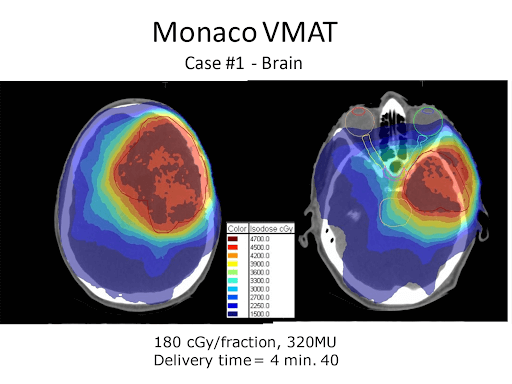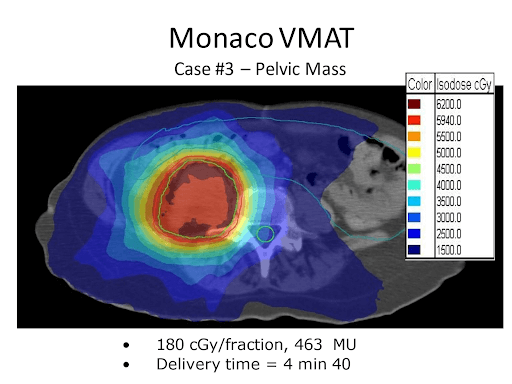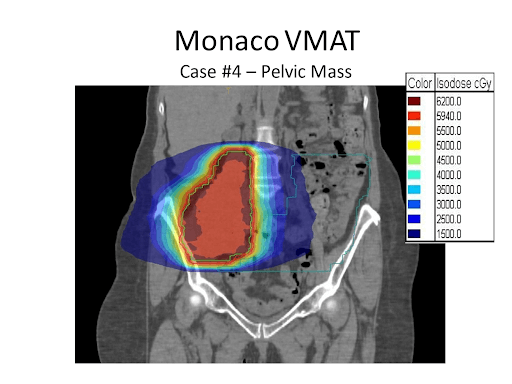Head & Neck Cases
LINAC BASED STEREOTACTIC RADIOSURGERY(SRS)
STEREOTACTIC ABLATIVE RADIOTHERAPY (SABR)
STEREOTACTIC BODY RADIATION THERAPY (SBRT)

AZHAR RASHID
MBBS, BSc, FCPS Radiotherapy, MSc Oncology (UK)
Director, Linac Based Stereotactic Radiosurgery
Director, Post Graduate Residency & Training Program
Consultant Clinical & Radiation Oncologist
Email: azhar_rashid@hotmail.com
Overview
Dr Azhar Rashid is a pleasant, friendly, and renowned leading cancer specialist in the country. He has 25 years’ experience in dealing with various type of cancer patients. Dr. Azhar Rashid was trained at a renowned cancer hospital of Pakistan and has worked over there as “Consultant Oncologist” from 2011-2014. He is privileged to have his Masters in Oncology from Nottingham University Hospital UK and specialist training certificates from Germany, Japan, Czech Republic, etc.
Specialty
- Oncologist
Associations/Certifications
He developed first stereotactic radiosurgery(SRS) program in Pakistan in the field of clinical & radiation oncology at a reputable cancer institute in Karahci. He is Director and HoD Oncology over there. His department is accredited from CPSP for Post graduate training. He is approved Supervisor/Examiner for FCPS-Radiation Oncology in College of Physicians & Surgeons Pakistan (CPSP) – Since 2012. He is an active oncologist who holds key post of Head of Research & Development of Pakistan Society of Clinical Oncology (PSCO). He has been elected multiple times for Executive council. He is keen in developing international relations with other societies and supporting the fight against cancer globally. He has multiple publications in National & International Journals, >100 Presentations, >150 abstract writings. He is the reviewer of multiple National & International Journals.
Clinical/Surgical Focus
Cancer Specialist, dealing with non-surgical cancer patient management. Cancer Patient Counselling, Cancer Screening, Cancer diagnostics, Cancer staging, management and Cancer Patient survivorship are the key areas that he looks after
Area of Expertise
Expert in Systemic anticancer therapies like chemotherapy, hormone therapy, targeted agents and Immunotherapy as well as “Modern Precision Radiotherapy” like Stereotactic Radiosurgery-SRS /IMRT/SRT/SBRT/VMAT. Dealing with: Breast Cancer, Head & Neck, Brain, Spine, Prostate, Bladder, Kidney, Rectum and food pipe cancers, Gynae-oncology, Uterus, Ovary, Sarcoma, Lung and Liver cancers, etc. His dedication towards cancer patient management, up-gradation of training and research in clinical & radiation oncology in Pakistan is utmost.
What Is Stereotactic Radiotherapy (SABR/SBRT)?
Stereotactic ablative radiotherapy (SABR), also known as stereotactic body radiation therapy (SBRT), is a highly focused radiation treatment that gives an intense dose of radiation from multiple sources converging on the lesion, thereby giving a high radiation dose to the target lesion with relative sparing of the surrounding normal healthy tissues.
It has become a treatment of choice for many people with tumors for whom surgery may not be an optimal treatment.
SBRT relies on several technologies:
- 3-D imaging and localization techniques that determine the exact coordinates of the lesion within the body
- Systems to immobilize and carefully position the patient and maintain the patient position during therapy as well so no misregistration takes place.
- Highly focused x-ray beams that converge on a tumor or abnormality
- Image-Guided Radiation Therapy (IGRT)which uses medical imaging to confirm the location of a tumor immediately before, and in some cases, during the delivery of radiation. IGRT improves the precision and accuracy of the treatment.
- Three-dimensional imaging, such as CT, MRI, and PET/CT is used to locate the tumor or abnormality within the body and define its exact size and shape. These images also guide the treatment planning—in which beams of radiation are designed to converge on the target area from different angles and planes—as well as the careful positioning of the patient for therapy sessions.
What is the time duration of SBRT treatment?
The SBRT treatments are performed mostly as outpatient visits of 30 minutes to an hour, requiring no hospitalization. Treatment courses are generally completed in 1-5 days so the patients are not bound for long periods of time especially if they are visiting from outside the city.
What are the advantages of SBRT at NCCI?
- Fast & rapid delivery
- Shorter treatment duration
- No fiducials or any invasive procedure before treatment
- No long waiting times
- Start treatment within two working days after simulation.
- For Emergency cases, same day start of treatment.
- Painless
- Bloodless
- No Anesthesia for adults.
- Shorter treatment duration
- No touch technique (No tool will touch your body)
- Safe, precise and targeted
- In-house admissions facility available, if required.
How to Prepare for SBRT:
Preparation for stereotactic body radiotherapy varies depending on the condition and body area being treated.
Food and Medications
- You might be asked not to eat or drink anything 2 to 3 hours before the procedure.
- Please ask your consulting physician about whether you can take your regular medicines the night before or morning of the procedure.
Clothing and Personal Items
- Wear comfortable, loose clothing.
- You might be asked not to wear:
- Jewelry.
- Eyeglasses.
- Contact lenses.
- Nail polish.
- Dentures.
- Wigs or hairpieces.
What to Expect During the Hospital Visit for SBRT:
Stereotactic body radiotherapy is usually an outpatient procedure. This means you likely won’t need to stay in the hospital after treatment.
Each treatment takes up to an hour. It is usually recommended that you have a family member or friend accompany you for the duration of the treatment.
Before the Procedure:
The SBRT staff at NCCI will takes several steps before stereotactic body radiotherapy. Steps might include:
- To target treatment exactly, the person getting treated must remain completely still. This will be done with the help of the onsite clinical staff often using custom made devices to hold you in place and keep you comfortable.
- Once you’re in place, imaging scans get information about your tumor, including location, size and shape. A scan also can show how the tumor moves while you breathe. Planning. Using the imaging scans and specialized software, the NCCI SBRT team plans the best approach to treatment.
During the Procedure:
Children might receive medicine to put them in a sleep-like state during the procedure. Adults typically don’t need this medicine. If you feel very nervous about your treatment, you might receive medicine to help you relax.
You’ll be able to talk to a member of NCCI staff during the procedure.
Results of The Treatment:
The effects of stereotactic body radiotherapy treatment happen over time. Stereotactic body radiotherapy might result in the following:
- Tumors that aren’t cancerous, which are called benign tumors, might take 18 months to 2 years to shrink. The main goal of treatment for benign tumors is to keep the tumor from growing.
- Cancerous tumors might shrink faster, maybe within a few months.
You may have follow-up exams and tests to monitor your progress after stereotactic body radiotherapy.
How Does SBRT Differ From Conventional Therapy?
- With conventional therapy, radiation is delivered in relatively small doses over the course of several weeks, with patients receiving daily treatments during that time.
- With SBRT, the oncologists at NCCI are able to deliver a greater combined dose of radiation over the course of far fewer treatments.
- SBRT has shown dramatically better outcomes than conventional radiation therapy.
- Whereas two-year success rates for conventional treatment range from 30 to 40 percent, the success rates for SBRT range from 80% to 90 %— comparable to those of resection surgery but with far fewer risks.
- Despite the fact that SBRT delivers higher biological dosage of radiation, patients have experienced fewer side effects, including radiation pneumonia. Slight fatigue for one week following treatment is SBRT’s most common side effect.
- Completely painless procedure.
Clinical Team at NCCI:
The people involved in the SBRT treatment of patients include;
- Radiation Oncologist
- Medical physicists
- Radiation technologists
- Radiation nurses
- Numerous ancillary staff
Radiation oncologists work with medical physicists to develop a radiation plan that ensures safe exposure to normal structures. Each of the treatment sessions takes 30 to 60 minutes and, unlike with more invasive therapies, the patient leaves each treatment free of significant pain or side effects. Treatments do not have to be administered on consecutive days, but the entire course of therapy is usually concluded within 10 days.
What Are the Indications For Stereotactic Body Radiation Therapy (SBRT)?
SBRT is used for the effective treatment of multiple pathologies of the body some of which are as under;
- Primary lung cancer and tumors that have spread to the lungs
- Pancreatic tumors
- Bile duct tumors
- Primary and metastatic liver tumors
- Kidney tumors
- Prostate cancer
- Pelvic tumors
- Sarcomas
- Metastatic tumors throughout the body (otherwise known as oligometastases)
- In certain circumstances, we also offer SBRT as the modality of choice for patients that have previously received a full dose of external beam radiation therapy and now have recurrent but localized tumors.
At NCCI, SBRT has become the mainstay of radiation therapy for whole body tumors for the simple reasons of accurate and custom mapping for each individual patient’s anatomy and organ motion so that we may be able to optimally target the tumor and simultaneously spare the surrounding normal tissue.
The clinical experience that our expert radiation oncologists have garnered over the last decade allowing them to make sound treatment decisions regarding therapy with SBRT and assure an efficacious and safe SBRT radiation plan at the time of treatment.
Instead of several weeks of conventional radiation therapy, patients complete their SBRT in a short-period of time, usually over a one-week period, minimizing the inconvenience of daily trips to the radiation oncology facility.
Clinical & Radiation Oncology
Radiation oncology (radiotherapy/radiation therapy) is a branch of medicine that is an essential part of a multi-disciplinary approach to cancer patient management. It uses high energy x rays (photons) most commonly delivered through a linear accelerator. Gamma Knife, or Co60 Teletherapy, Proton Therapy, or Carbon Ion therapy are the part of Radiation Oncology.
It is estimated that about half of cancer patients will benefit from radiation therapy as part of their overall cancer treatment. It means one out of two patients of cancer will get the actual benefit of radiation therapy during their illness.
Radiation therapy is a local treatment like surgery and has the limited side effects over the treated area only, and has no bad effects on blood cells or body. Radiation therapy is highly cost-effective cancer treatment that completes in one day to five days in radiosurgery and maximum in 35 days in conventional radiation therapy treatments. It is very strong modality to control cancer pain and cancer bleeding in the body. Radiation therapy plays an important role in cure of cancer. All cancers that are cured, 40% of them receive radiation therapy during the course of treatment. While radiation is being used in palliative setting in almost 100 % of the solid tumors.
As we all know, cancer being the leading cause of death world-wide, improvement in radiation oncology treatments will help cancer patient access to radiation therapy for cure of tumor.
At NCCI, we have an extra ordinary setup of state-of-the-art radiation therapy units that provide treatments at par with international standards, providing excellence in radiation therapy.
Gamma Knife® ICON™, Elekta-Synergy-S® and Elekta Synergy-Agility® are the most modern radiation therapeutic units all over the world, and it is with the help of these the treatment therapies at NCCI are comparable to any of the services that are being provided all over the world. Because of these facilities and the treatment options available for the patients there is a higher cure rate for the patients. The techniques that are in use at NCCI result in
- Fewer side effects
- Faster treatment times
- Reduced number of treatments
- Motion management systems and tumor tracking ability allows us to deliver radiation dose very precisely and targeted while limiting damage to important adjacently lying normal organs.
- Advances in real-time imaging with CT (4-D CT) and MRIs empowers Radiation Oncology teams to compensate for patient movements, like breathing.
- Adaptive radiation therapy allows to change the treatment plans during treatment by observing the changes in tumor shape and size.
NCCI is the pioneering institute of Pakistan in Stereotactic Radiosurgery of Brain and Body. Brain & spine tumors in adults and children, who require radiation therapy to the whole brain and whole spine can be artistically treated (by using the technique of Craniospinal Irradiation- CSI) here with two of our most modern linear accelerators.
Following Radiation Therapy Techniques available at NCCI
- 3D-CRT: 3-D Conformal Radiotherapy
- IMRT: Intensity Modulated Radiotherapy
- IGRT: Image Guided Radiotherapy
- VMAT: Volumetric Modulated Radiotherapy
- SRS: Stereotactic Radiosurgery
- SBRT: Stereotactic Body Radiotherapy
- SABR: Stereotactic Ablative Radiotherapy
- GK-SRS: Gamma Knife Stereotactic Radiotherapy
- X-Knife SRS/SBRT: X-Knife Stereotactic Radiotherapy/Stereotactic Body Radiotherapy
Consultant Oncologists at NCCI;
- Azhar Rashid BSc, MBBS, FCPS (Radiotherapy), MSc Oncology (UK)
- Dr Muhammad Ali Memon MBBS, MCPS, FCPS (Radiotherapy)
- Dr Asghar H Asghar MBBS, FCPS (Radiotherapy), MSc Nuclear Medicine
For Medical & Radiation Oncology Appointments:
Monday through Saturday, 08:00am to 08:00pm
- UAN: 021-111-000-212, Ext 115 & 133
For Radiation Treatment Information & Appointment:
- Direct Landline # 021-32229836
- UAN: 021-111-000-212, Ext 115, & 133
SYNERGY-S® & SYNERGY-AGILITY®
STEREOTACTIC BODY RADIOTHERAPY (SBRT) AND STEREOTACTIC ABLATIVE RADIOTHERAPY (SABR) TECHNIQUES
“SYNERGY-S and SYNERGY-AGILITY” by Elekta is an image guided robotic linear accelerator that combines high conformance beam shaping with exclusive 3D adaptive image guided radiation therapy (IGRT) / Volumetric Modulated Arc Therapy (VMAT). It is dedicated for intra-cranial and extra-cranial applications.
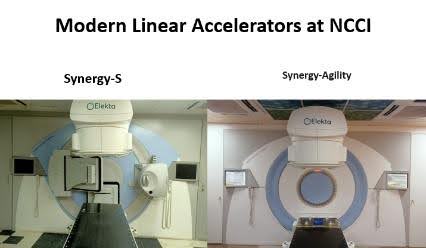
Decades have contributed to improved results and wider applications of radiosurgery. The role of radiosurgery has expended beyond its initial applications. Synergy-S is the ideal extra-cranial complement to Leksell Gamma Knife as combination of both creates stereotactic center of excellence.
It works like Gamma Knife having a head frame, body fix imaging, image planning and special modality of self-imaging planar fluoroscopic event/ and 300-ray volume imaging. Its own table to confirm the target and then treatment either radiosurgery or radiotherapy over confirmed target. It has maximum accuracy in advanced stereotactic radiosurgery with reference to spinal applications like spinal metastasis. Its fluoroscopic image modality prior to treatment helps to minimize the risk of set-up error by identifying critical structures during treatment, thus compensating organ motion like heart, lungs, larynx and abdominal structures.
Having Synergy-S multi-leaves (micro-macro) collimator system in conjunction with powerful software driven 2D & 3D image-guided accuracy, enables oncologists to apply SRS/SBRT effectively for small and large field lesions.
INDICATIONS:
- Intracranial Indications:
- Large tumors, tumors closely lying near to critical organs, tumors embedded into the organ at risk or microscopic disease, etc.
- Benign:
- Meningioma, Pituitary Adenoma, Acoustic Schwannoma, AVM, Cavernoma, Functional disorders, Psychiatric disorders, etc.
- Malignant:
- Brain Metastases, Recurrent Gliomas, etc.
- Extra Cranial Indications:
- SBRT is now a standard procedure for many of the extra-cranial regions including: Spine, Lung, Liver, Prostate, and Oligometases (New concept with cure or radical treatment with SBRT/SRS in stage –IV Cancers.
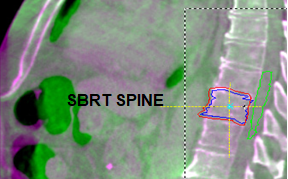
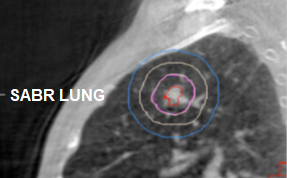
Volumetric Modulated Arc Therapy (VMAT)
It was introduced in 2007 and was described as a novel radiation technique that has continuous modulation of MLCs (field shaping), along with the dose rate and gantry speed rotation utilized to deliver highly conformal dose distributions simultaneously, in a minimal time period with reasonable MUs to be delivered.
VMAT carries an advantage over IMAT in terms of greater degree of freedom that increase the capability of beam intensity modulation. Teoh et al. published comprehensive review article on VMAT in 2011.
VMAT is becoming an increasingly utilized radiation technique. It has proved as a novel and emerging technology with freedom of selection of number of arcs and some other features making it more efficient and faster in terms of treatment time and MUs delivery, its ability to spread low dose to a wide area of normal tissue, ability to deliver complex treatments with coplanar or non-coplanar single or multiple arcs make it a unique technology. The risk of secondary malignancy in VMAT should be lower as VMAT generally uses fewer monitor units (MU) compared with conventional fixed field IMRT. Macchia et al, published a detailed review of VMAT and its clinical use for various body sites in 2017, this study described that VMAT has been used mostly for brain tumors, head & neck, thoracic cancers, GU cancers, GI cancers and SBRT for oligometastases.
VMAT-SIB is a popular technique that allows treatment of several volumes with different dose prescriptions called simultaneous integrated boost (SIB) is conveniently executed with VMAT technology that results into delivery of high biological effective doses to the target and reduction of the dose to the surrounding normal tissues and improvement of the toxicity. Macchia et al, concluded that the clinical use of VMAT is less documented, but VMAT-SIB and VMAT-SBRT is an effective and safe technique for various cancers of the body. More clinical data will emerge by the time as the numbers of patients are increasing across the world.
VMAT-SRS is a reliable therapeutic modality of SRS based upon the existing diametric research on its safety and benefits particularly in multiple brain metastases. They considered VMAT similar to the “non-VMAT” approach in terms of treatment plan acceptability (conformity and heterogeneity), treating multiple lesions and offering frameless radiosurgery treatments under image guidance.
In 2008, Gamma knife & Linac based Stereotactic Radiosurgery/Radiotherapy was established at Neurospinal & Cancer Care Institute (NCCI) Karachi by Prof. A. Sattar M Hashim.
Our group emerged as a pioneer of stereotactic radiosurgery (SRS) /stereotactic body radiotherapy (SBRT) in Pakistan. Initially we were using various forms of IMRT: fixed beam, step and shoot, forward and inverse IMRT from 2008 till 2013.
Later we were able to acquire a license to use VMAT technology in Pakistan and since 2014 we are using VMAT, VMAT-SIB and VMAT-SRS/SBRT techniques on a regular basis.
SYNERGY-S / SYNERGY-AGILITY
Along with Synergy-S, Another New Linear Accelerator “SYNERGY-AGILITY has already been Installed at NCCI to carry out Stereotactic Body Radiotherapy.
Revolutionary Accuracy In Treatment Delivery
Synergy-S is the only fully digitally controlled linear accelerator available for extra-craniaI stereotactic applications. It is the first system of its kind with 3D imaging of the target area at the point of treatment delivery. We call this 4D Adaptive IGRT – high-resolution imaging in three dimensions of physical space and the tooth dimension of time.
Dose Control And High Conformance
Synergy-S delivers high dose rates with exceptionally fine control and precision. The system enhances avoidance of critical structures during beam delivery with its innovative 3D imaging technology. This technology allows beam adaptation for individual treatment sessions to achieve high precision and excellent target conformance, plus, digital controls which maximize the accuracy of dose delivery without compromise.
Synergy- S offers with stable dose/emu calibration and the most accurate IMRT/VMAT delivery available.
Multi-Modality Energy Flexibility
Synergy-S offers an unprecedented selection of therapeutically effective X-ray beams. With the flexibility to select a higher energy X-ray beam than AMA, physicians can optimize the dose distribution by choosing energy appropriate to the site and depth of the lesion.
Intelligent Beam Shaping
Agility is the next generation, high resolution beam shaping solution from Elekta. Built on a strong understanding of the factors that are critical to patient plan optimization and treatment delivery, Agility is designed to meet the needs of modern radiotherapy facilities. Agility offers excellent clinical flexibility and efficiency, while ensuring that patient safety and comfort remain a priority.
Rapid Leaf



40 x 40 cm field size.One hundred and sixty Inter digitating leaves with 5 mm width at isocenter. Integrated digital control of leaves and dynamic leaf guides. Accurate leaf positioning with Rubicon optical technology. Rapid leaf speed. Extremely low leaf transmission (<0.5%). 45 cm isocentric clearance.
Shorter Treatment Times
The high leaf and diaphragm speed provided by Agility increases the speed of delivery and allows higher dose rates to be used for more effective modulation. Not only does this help to improve plan quality, but it also shortens treatment times considerably. Shorter treatment times mean that more patients can be treated in a working day.
Multifunctional
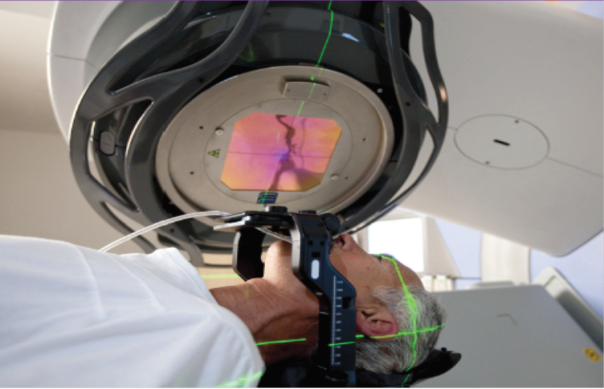
Agility is ideal for the treatment of large or small field shapes and for the delivery of static or dynamic treatment plans for conventional or stereotactic techniques. You can even deliver off-center, non-coplanar treatment plans.
Agility offers high resolution beam shaping, including interdigitation, across the 40 x 40 cm field size. Synchronized intelligent dynamic leaf guide movement and individual leaf movement achieves enhanced leaf speed and removes the need for a split field for seamless delivery of each prescribed beam shape.
These features combined with a market leading 45 cm iso-centric clearance ensure that your Linac is truly multi-functional.
Rubicon Optical Positioning System
The robust and reliable “Rubicon optical positioning system” provides valuable real-time assurance of accurate leaf positioning. Agility’s Rubicon optical technology offers advanced real-time leaf monitoring and positioning. Ultraviolet light from an LED source produces infrared fluorescence when it falls on the ruby tips of the multileaf collimator leaves. This infrared fluorescence, detected by an infrared camera, is used to reliably monitor and accurately position the leaves and can be viewed in real-time on the linear accelerators display screen.
Inherent Safety Supervisor
In addition, Integrity™, the fully integrated Elekta digital control system, provides: Continuous monitoring and control throughout treatment for confidence in beam shaping and treatment delivery. Verification that the field being delivered matches the prescribed treatment parameters. Inherent safety features that supervise and check that all systems are operating correctly.
Lowest Leaf Transmission
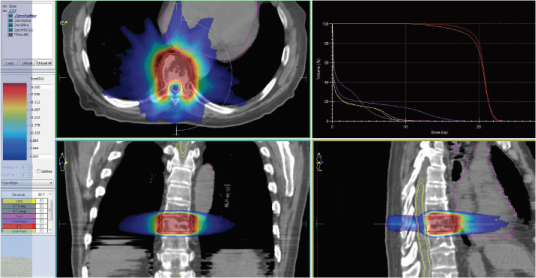
The transmission and penumbra measurements indicate a significant improvement on the published data for comparable equipment. In particular, leaf transmission is extremely low, less than 0.5%. Cosgrove et al (2009). Agility has exceptionally low leaf transmission at less than 0.5% across the entire field1. This is important for a number of reasons:
It reduces unwanted dose to organs at risk and healthy tissue. Low integral dose reduces the risk of inducing secondary tumors. It reduces off axis dose when performing off-axis beam shaping. It improves treatment plan quality.
High-Resolution Beam-Shaping
Synergy S and Synergy-Agility includes an integrated multi leaf collimator with a generous 40cm x 40 cm field size. The field comprises 160 individually controlled leaves. Physicists can create a range of finely shaped, high-resolution fields within one field simultaneously. This contributes to patient safety and improved conformal avoidance of critical structures.
Beam Angle Flexibility
Synergy S and Synergy-Agility features a small diameter 62cm treatment head which in combination with the best isocenter clearance, maximizes clearance around the patient and contributes to the wide variety of treatment approaches possible, including non-coplanar treatments. This enables Synergy S and Synergy-Agility to deliver radiation from angles impossible to replicate with other systems. Synergy S and Synergy-Agility can also radiate from underneath the couch for spinal applications, with the patient in the supine position.
Complete Quality Assurance
Integrated quality assurance (QA) tools ‘whole a kV/MV phantom to maintain excellent image quality and automated multi-leaf calibration software for the beam modulator that utilizes iView-GT MV images. This turnkey QA package enables the physics team to maximize efficiency and maintain the highest levels of device precision.
ABSOLUTE ACCURACY IN PLANNING- MONACO 5.11 – TPS
Synergy S and Synergy-Agility integrates a suite of sophisticated software tools to provide unprecedented target accuracy and help improve patient outcomes. Monaco-5.11- Treatment Planning System (TPS) reduces complexity and enables Physicists to create high-precision plans that are easy to deliver and verify. It supports all linear accelerator clinical techniques.
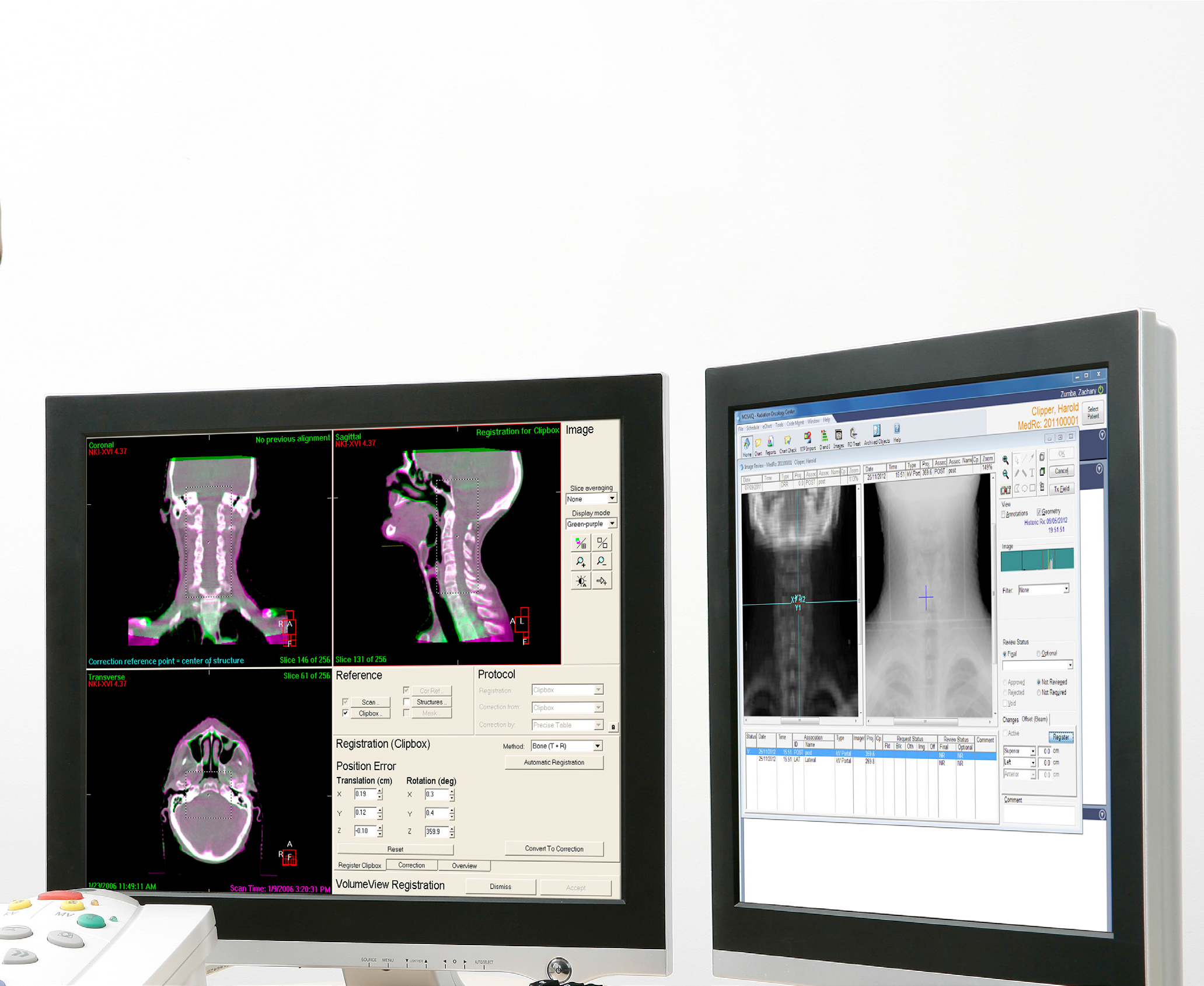
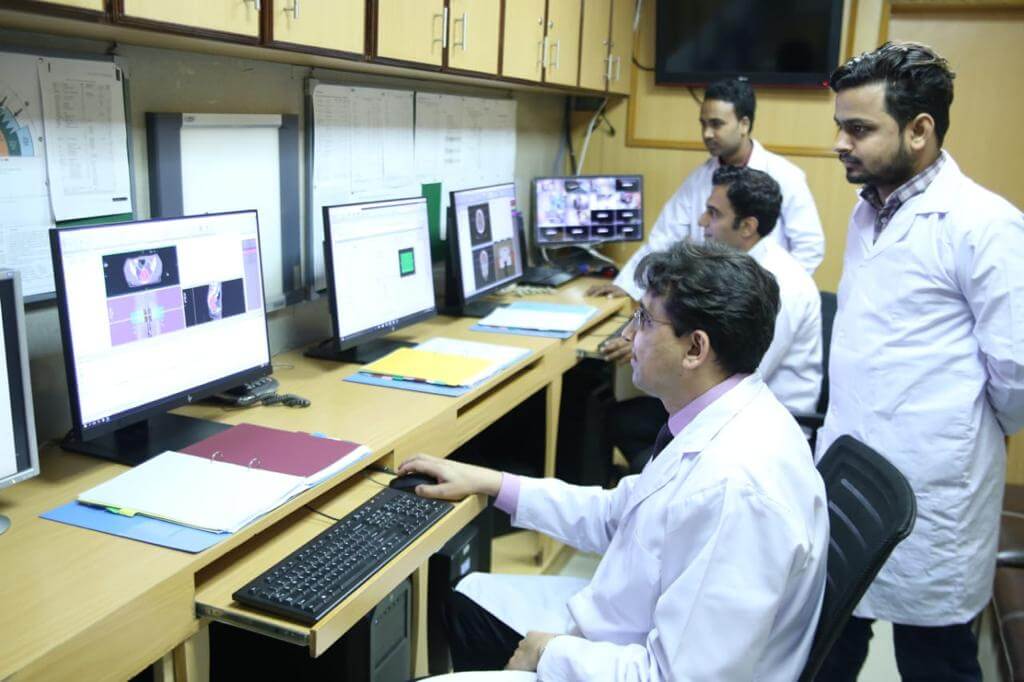
Modern TPS-Monaco-5.11 is placed with the following techniques availability:
3D conformal radiation therapy, IMRT, VMAT, Stereotactic MLC and Cones.
Extreme Flexibility
Planners can run multiple plans simultaneously, switching instantaneously from one patient to another without having to save work and exit. Planners can also switch instantly from contouring to planning, from 2D to 3D, or many other Precise PLAN mode, this significantly improves planning efficiency. Workflow can be further improved by using Windows remote access planning (WRAP.) which supports client workstations away from the dosimetry room servers.
Accurate Imaging
With Monaco-5.11- TPS, MR and CT, PET-CT images can easily be included in the treatment plan. The software transfers images directly from scanners, ensuring seamless integration and instant access to critical information. Planners can also easily import contoured images from virtual simulation systems.
Fast Contouring
Monaco-5.11- TPS supports fast structure contouring via manual or automatic outlining. Bony anatomy, organs and other critical structures can be found automatically. For manually entered contours, copy and paste and interpolation tools can be used to copy structures onto neighboring slices for rapid contouring without redrawing. Ultimately, reducing the true spent planning.
Customized Evaluation
Monaco-5.11- TPS allows customization of planning workspace to match the clinic’s preferences, so that physicians can see the data in the preferred way. Multiple screens display any combination of axial, sagittal, coronal and oblique CT/MR images and can include both beams-eye-view (BEV) images and digitally reconstructed radiographs (DRRs). On every selected screen, Monaco-5.11- TPS calculated close rapidly for easy review and rapid evaluation.
3D Imaging-Volume View
Volume View software enables 3D volume imaging of soft tissue critical structures at the time of treatment and in the treatment position. Imaging can be repeated as often as necessary throughout the course of treatment. This allows margins to be reduced and uncertainties in target dimension, location and movement to be accommodated, minimizing the side effects of radiation, and allowing neurosurgeons to prescribe very high doses with confidence. Volume View will revolutionize the localization of tumor and critical organs during treatment delivery. It captures a complete 3D volume of the area of interest in a single acquisition, enabling rapid registration against the CT treatment plan image. Volume View ensures excellent spatial resolution and displays slices of anatomy in any direction with equally high resolution which is ideal for positional registration.
IGRT Verification
2-D, 3-D, 4D soft tissue imaging during treatment delivery. Verify anatomical position and motion during treatment. Increased confidence for dose escalation.
Record & Verify System
MOSAIQ is record & verify system. From Demographic information to treatment planning information, various department records and QA is available in this system. An Excellent tool for enhanced workflows for improvement of further clinical efficiency.
2D Monitoring – Motion View & Planar View
Motion View & Planar View imaging software, clinicians can monitor the effects of patient motion during treatment. Motion View is a unique 25 sequence mode that enables real-time viewing of anatomy while the patient is in the treatment position. Planar View offers exceptionally fast low-dose snapshots of the patient in the treatment position.
Beams-Eye-View Imaging – iView GT Mega
The iView-GT megavoltage portal imaging system provides a beams-eye-view of the treatment delivery. Enabling a unique view of what is being treated in real time.
Patient Immobilization Solutions
Comfortable body immobilization solutions available as follows:

Stereotactic Body Frame
Stereotactic Body Frame enables clinicians to localize tumors precisely in a 3D stereotactic coordinate system, increasing the accuracy of radiation delivery. It allows high dose treatments with minimal exposure to surrounding healthy tissues, establishing a reliable basis for hypo fraction.
With the Stereotactic Body Frame, Radiation Oncologist/Physicist can localize isocentric target coordinates during planning and treatment. The system includes built-in reference indicators (fiducial markers) for CT and MR determination of target coordinates.
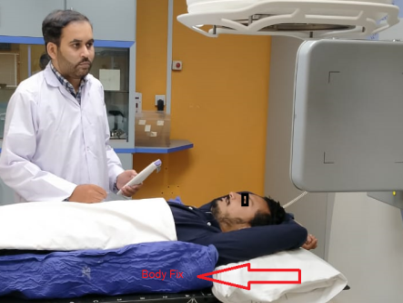
Body FIX RT
Body FIX- RT immobilizes firmly and gently throughout imaging, simulation and treatment. It is ideal for use with Synergy-S, In conjunction with Hexa POD Couch and minimizes involuntary patient movement during imaging and Radiotherapy. Body FIX- RT is composed entirely of radio-translucent materials compatible with CT, MR, PET, SPECT and ultrasound modalities.
Motion Management System
“Symmetry” Motion Management System assures the physiologic body motion control during treatment.
4-D CT and 4-D Treatment Planning compliments the motion control during Stereotactic radiosurgery treatment. Easy and Friendly software, keeps patient’s breathing comfortable during

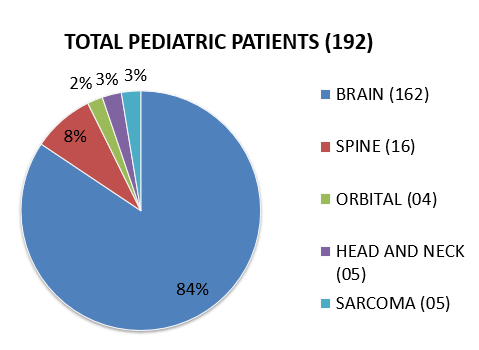
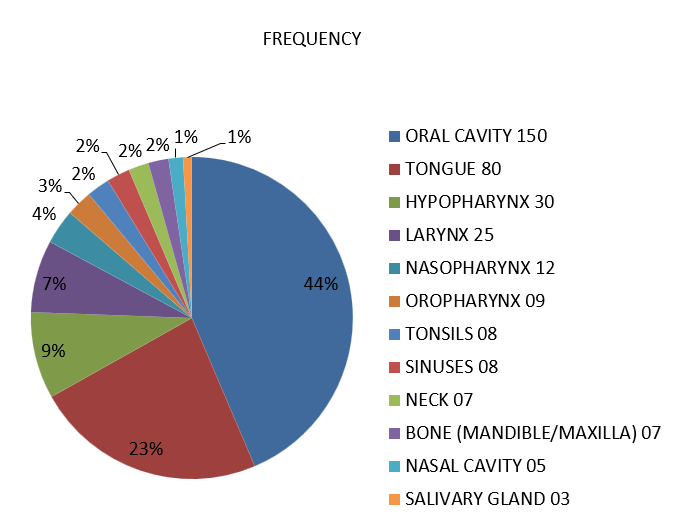
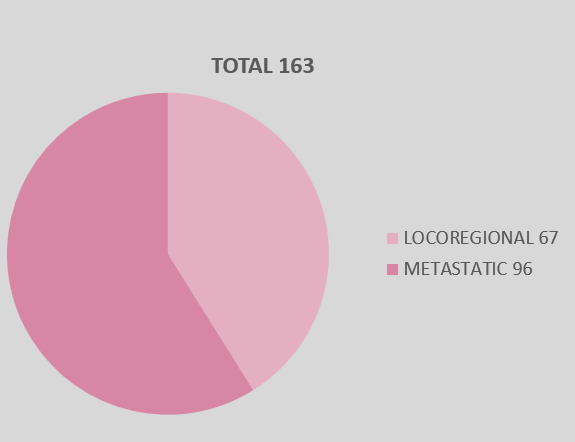
Breast Cancer Cases
NCCI CLINICAL & RADIATION ONCOLOGY CASE REPORTS
SRS / VMAT For Multiple Brain Metastases On Synergy-S
CT simulation was performed with thermoplastic sheet and SRS / VMAT planning was carried out on ERGO ++. Excellent Dose distribution was achieved on two arcs and calculated treatment time was 11 minutes. SRS dose prescription was 20 Gy single fraction at 70 % isodose line.

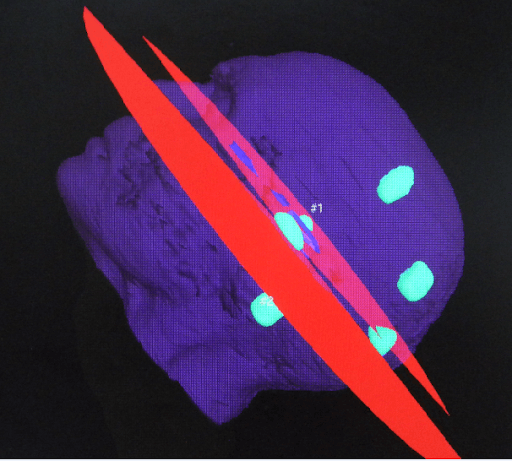
Pic(1)- Location and Volumes of Six brain metastases were contoured
Left temporal met: 1.8 cc
Left parietal met: 2.1 cc
Left posterior parietal met: 2.2 cc
Left Occipital met: 1.2 cc
Right parietal met: 0.3 cc
Right cerebellar met: 2.9 cc
Pic-(2)- SRS/ VMAT Plan was prepared with the help of two arcs, all the contoured mets were well covered with prescription isodose line of 70 %.
Total treatment time was 11 minutes.

Pic-(3)- Computerized Planning on Treatment planning system ERGO ++. Green line around the target is prescription isodose line of 70 %. Blue line is 50 % isodose line.
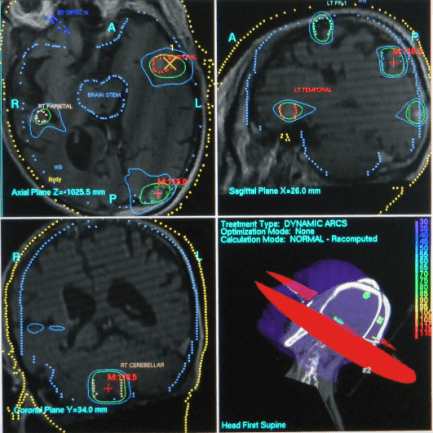
In conclusion following benefits were achieved from this treatment.
- Shortest treatment time (4-11 min) to execute the standard dose of radiation therapy.
- Non-Invasive procedure (no fiducials or screws), No anesthesia, No bleeding, No pain.
- Very high doses to each metastasis – Good local control.
- Lowest dose to the critical organs at risk. Minimal side effects.
- Sparing of hippocampus.
- No long-term memory impairment.
- No cognitive impairment.
- Rapid improvement in performance status to continue the systemic therapy.
- Continue daily routine work, no rest, no hospitalization, no holidays required. Day care procedure. Discharged on the same day, 60 min after the procedure.
- Treatment of choice in brain metastases for the oncologist, neurosurgeons and other clinicians.
VMAT – FAN SHAPED BEAM PLANNING DISPLAY
Rt rib metastases was planned for 8 Gy x 3 Fr @ 70 % isodose line.
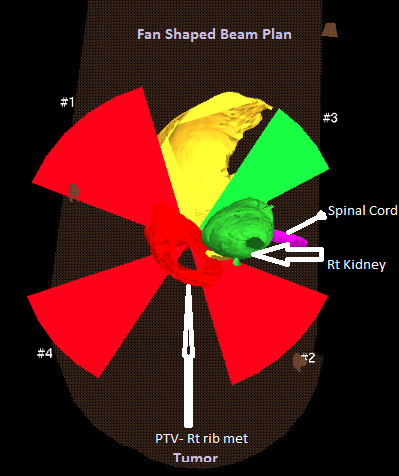
Fan Shaped Beam Planning display
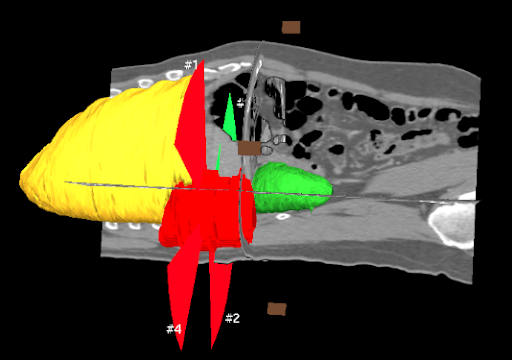
Fan Shaped Beam Planning with CT Images
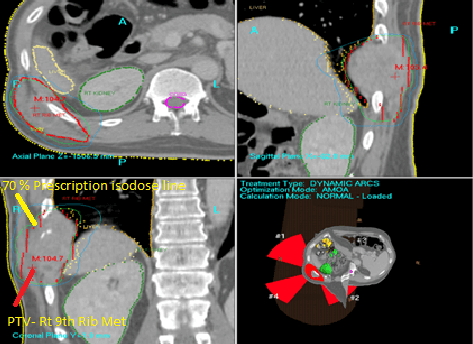
Three-Dimensional view of Fan Beam Shaped Planning of VMAT
Fan Shaped Beam Planning with CT Images
RADIATION PLANNING IN VARIOUS REGIONS OF THE BODY (SHORTEST TREATMENT TIME)
